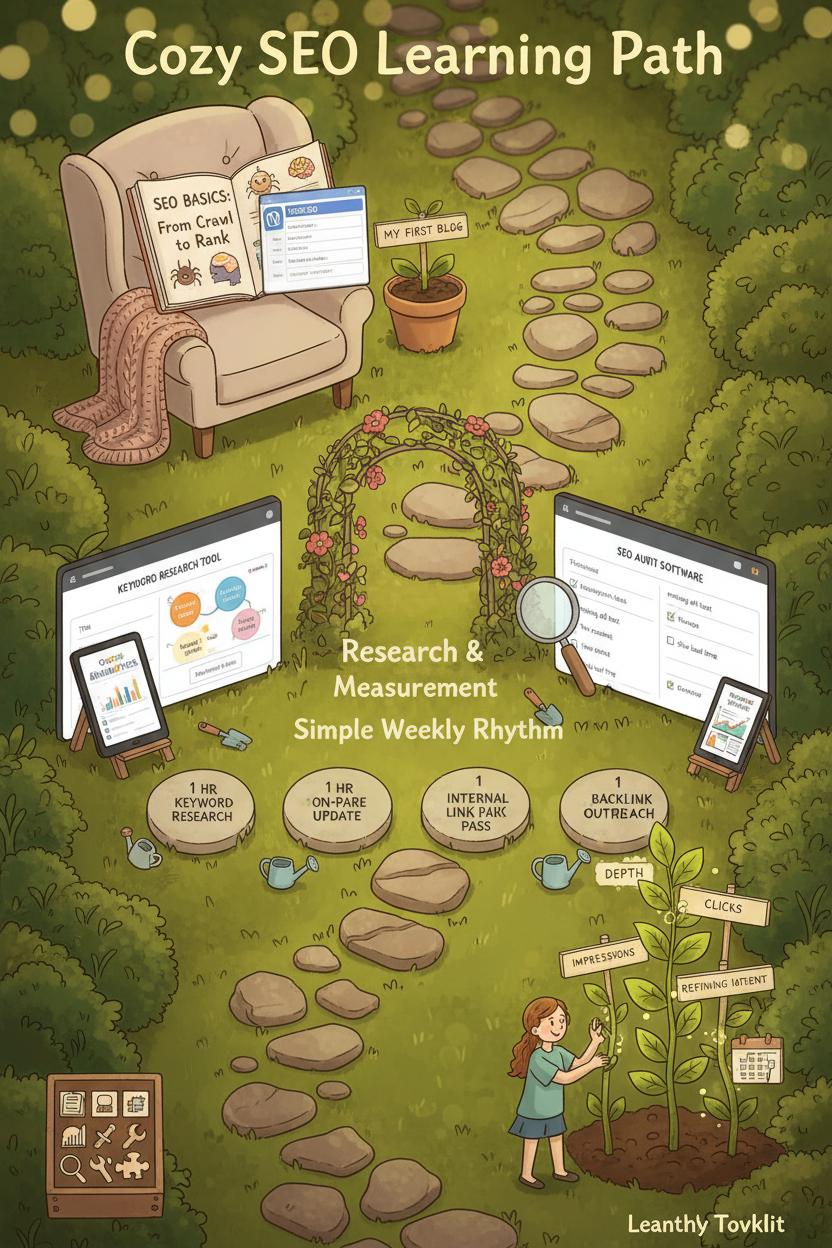Curious how does seo work? In this quick guide to SEO basics, we unpack search engine optimization—how bots crawl, index, and rank—so your content gets seen. Learn simple keyword research moves, on-page tweaks, and smart backlinks that build authority. Whether you’re skimming an SEO book, testing a keyword research tool, or trying new SEO software, you’ll find practical steps you can apply today. We’ll also touch a Google Analytics guide for tracking wins and a WordPress SEO plugin to optimize posts. Pin now, rank later!
Crawl: How Search Engines Discover Your Pages

Before a page can shine in search, it has to be found. When people ask, how does seo work, the crawl is the first quiet step—little bots gliding through the web, following paths from one link to the next. In seo basics, imagine your site as a cozy home at the end of a path: links are your stepping stones, and sitemaps are the hand-drawn map tacked to the door. Search engines discover pages through internal links, XML sitemaps, and backlinks from other sites. If a page isn’t linked anywhere, it’s like a lovely room with no doorway—beautiful, but invisible. That’s why smart search engine optimization starts with making discovery effortless.
Give crawlers a clear path. Keep navigation simple, use descriptive anchor text, and link to new content from pages that already get visits. Generate and submit an XML sitemap, and make sure robots.txt isn’t accidentally blocking important sections. A WordPress SEO plugin can help with sitemaps, canonical tags, and noindex settings for thin or duplicate pages. Avoid orphan pages, keep essential content within a few clicks of the homepage, and be mindful with JavaScript-heavy designs—if content only appears after a scroll or click, provide an HTML fallback so bots can see it. Fresh content informed by thoughtful keyword research naturally attracts visitors and, over time, more backlinks that invite crawlers back more often.
Technical hygiene matters, too. Fast pages get crawled more efficiently; aim for clean 200 status codes, use 301s for moves, and fix 404s and 5xx errors that waste crawl budget. Large sites should prune outdated URLs and consolidate duplicates to reduce noise. If you love tools, an SEO software suite can flag crawl traps, while a keyword research tool helps you plan hubs that are easy to navigate. Pair your efforts with a Google Analytics guide to understand how discovered pages turn into traffic. And if you’re learning the ropes, an approachable SEO book can make the crawl stage feel less mysterious—because being discoverable isn’t just technical, it’s the gentle art of guiding both people and bots to the good stuff.
Rank: The Signals That Order Search Results

Once your pages are crawled and indexed, ranking is where the magic gets sorted—like arranging a mood board so the most on-theme images float to the top. Search engines look first for relevance: does your page clearly answer the searcher’s intent? This is where thoughtful keyword research pays off, not as a clunky checklist but as a way to speak your audience’s language. Sprinkle those terms where they belong—title, headers, intro, image alt text—while keeping your voice natural and readable. Freshness, depth, and clarity matter, too. Helpful structure, scannable subheads, and visuals all signal that your content will satisfy a real person, not just a robot. Technical polish supports this: clean HTML, fast load times, mobile friendliness, HTTPS, and tidy internal links help search engines understand and trust your pages. Think of ranking as the final step in how does seo work: the right content, in the right format, delivered smoothly.
Authority is the other half of the story. Backlinks act like word-of-mouth recommendations, and quality trumps quantity—one thoughtful link from a respected, topically relevant site can outweigh a handful of random ones. Brand signals, expert authorship, and consistent citations reinforce trust, while clear page experience keeps visitors engaged. Over time, use data to fine-tune: watch queries, impressions, and conversions to see what resonates. This is where seo basics meet everyday practice in search engine optimization—consistent publishing, careful on-page work, and a strategy to earn and deserve links. Tools can make it easier: an SEO book for fundamentals, a keyword research tool to map intent, SEO software for audits, a WordPress SEO plugin to streamline on-page tweaks, and a Google Analytics guide to interpret performance. When these pieces click, your pages rise not by accident, but because they’re the most relevant, reliable, and delightful answer available.
Keyword Research Foundations: Topics, Intent, and Opportunities

Before we worry about scoring backlinks or polishing title tags, we start with keyword research—the quiet, thoughtful part of search engine optimization where you learn the language your audience already speaks. Picture a mood board filled with topics your readers care about: questions they ask at 11 p.m., products they compare on lunch breaks, problems they want solved before Monday. From there, map intent. Are they browsing for ideas (informational), ready to buy (transactional), or trying to find a specific brand (navigational)? This intent becomes your compass. When you understand how does seo work at the searcher level, your content naturally lines up with what Google is trying to serve. Topic clusters help here: group related ideas around a pillar page, then create supportive posts that link to each other, making it easier for bots to crawl, index, and rank your site confidently.
Opportunities pop up when you peek at the search results and notice gaps. Maybe the top results skip a how-to that your audience craves, or the guides are dated and overly technical—your chance to write the warm, step-by-step version with visuals and clear takeaways. A good keyword research tool or lightweight SEO software can reveal long-tail phrases with kinder competition and strong intent, while a trusty SEO book can firm up your seo basics so you know which phrases deserve a full guide versus a short section. As you plan content, pair each keyword with a purpose and a next step: an internal link to a deeper article, a comparison chart, a checklist download. Use a WordPress SEO plugin to refine titles and meta descriptions so your intent is obvious at a glance, and keep a simple spreadsheet tied to a Google Analytics guide to measure which pages actually pull in visitors and lead to conversions. Over time, consistent, intent-matched content attracts natural backlinks, reinforcing your authority. That’s the cozy secret of keyword research: when you choose topics with care and write for human intent, crawling and indexing become smoother, and ranking feels less like a lottery and more like a garden you’re patiently growing.
On-Page Optimization: Titles, Meta, Headers, and Internal Links

Think of on-page optimization like styling your favorite shelf: the pieces are small, but together they make everything feel intentional and easy to find. Start with your title tag, that tiny sign on the storefront that tells both people and crawlers what’s inside. Front-load your primary phrase (the one your keyword research says readers actually use), keep it crisp, and answer a clear intent—someone typing “how does seo work” is craving a promise of clarity. Your meta description is the friendly invitation; write it like a mini story with a benefit and a gentle nudge to click. While it doesn’t directly rank, it does win attention, and attention fuels those satisfying click-throughs that tell search engine optimization systems you’re what searchers wanted.
Headers are your cozy, labeled baskets. One H1 sets the theme, H2s break chapters, and H3s hold the finer details. Sprinkle in related phrases you uncovered during seo basics—synonyms and supporting terms—so the page reads naturally while mapping neatly to how engines parse context. If you’re building on WordPress, a WordPress SEO plugin can preview titles and snippets before you publish, and flipping through a well-thumbed SEO book can help you master structure without overthinking it. Keep the flow skimmable for humans, but semantically tidy for crawlers: short, descriptive headings, no stuffing, and a clear arc from promise to payoff. Track what resonates with a Google Analytics guide so you can refine over time.
Internal links are the warm fairy lights that guide visitors deeper. Use descriptive anchor text (“email subject line ideas” beats “click here”), and link from newer posts to older gems and vice versa to avoid orphaned pages. Create small topic clusters—your main guide supported by complementary how-tos—so authority can cascade inward, especially when a few strong backlinks land on your cornerstone content. Regularly audit and refresh these pathways with an SEO software crawl; it will surface broken links and missed opportunities. And when planning future posts, let a favorite keyword research tool help you map intent so each new page has a clear place to link to and from. Together, titles, meta, headers, and thoughtful internal links turn a single page into a connected experience that both readers and crawlers love.
Technical SEO Essentials: Speed, Mobile, Sitemaps, and Robots.txt

Before flashy content and clever headlines can shine, technical polish does the quiet heavy lifting—because that’s how does seo work at its core. Think of speed as your site’s first impression: compress images, use next‑gen formats, lazy‑load galleries, and cache pages so everything feels instant. A lightweight theme and a CDN can trim precious milliseconds, and a quick pass with SEO software or PageSpeed tests will flag bulky scripts that need pruning. This is seo basics, but it’s the foundation that lets search engine optimization actually pay off when crawlers arrive to evaluate your pages.
Mobile is the moment of truth. A responsive layout, generous tap targets, readable font sizes, and stable layouts (no jumpy buttons) make visitors linger. Keep third‑party widgets in check, defer nonessential JavaScript, and streamline navigation so thumbs can glide. Your keyword research should also consider mobile intent—what someone types on a phone is often shorter, local, and urgent—so use a favorite keyword research tool to compare mobile volumes and phrasing. A quick skim through a Google Analytics guide helps you spot device breakdowns, slow templates, and pages with high mobile bounce so you can fix what matters first.
Sitemaps and robots.txt are your gentle traffic directors. An XML sitemap is your curated museum map: only indexable, canonical URLs you’re proud to show, updated with lastmod dates and submitted in Search Console. If you’re on WordPress, a WordPress SEO plugin can auto‑generate clean sitemaps and keep them fresh as you publish. Robots.txt, meanwhile, is the velvet rope—great for keeping bots out of admin areas and test folders, but don’t block CSS or JS the bots need to render your pages, and don’t use it to hide private content. For that, rely on meta noindex or authentication. A friendly SEO book can demystify these tiny files, but remember the big picture: even brilliant content and glowing backlinks can’t rank if crawlers can’t reach or understand your site. Nail the crawl with solid technicals, guide the index with a pristine sitemap, and you’ll be ready to rank where your audience is already searching.
Content Strategy for Search: E-E-A-T and Topical Authority

If you’re wondering how does SEO work beyond the techy crawl-and-index talk, this is where content strategy comes in, all cozy under the blanket of E-E-A-T: Experience, Expertise, Authoritativeness, and Trustworthiness. Think of E-E-A-T as the style and substance that help search engines feel confident ranking you. When you consistently publish helpful, original pieces that show real-world experience—tutorials with your own photos, case studies, transparent pros and cons—Google can more clearly understand your value. Topical authority is the bigger picture: you’re not just writing one post about sourdough; you’re building the whole bakery. That means mapping a topic, answering every related question, interlinking posts so readers (and crawlers) can glide through, and keeping content fresh. It’s the elegant bridge from crawl to index to rank in the world of search engine optimization.
Start with seo basics: do thoughtful keyword research so each article targets a specific intent (learn, compare, buy) and supports your broader theme. A reliable keyword research tool helps you shape clusters and spot gaps, while a WordPress SEO plugin nudges you on metadata, internal links, and schema so your essentials are tidy. Pepper in credible citations, author bios with real credentials, and clear editorial standards to deepen trust. Backlinks still matter—especially those earned from relevant, reputable sites—so create assets worth citing: data roundups, templates, original visuals. If you’re studying on the go, an approachable SEO book can make the whole system feel less mysterious, and lightweight SEO software can audit your pages the way a crawler would, revealing broken links, thin content, and duplicate titles before they dull your shine.
Measure what resonates and refine. Pair a simple Google Analytics guide with Search Console to spot which queries surface your pages, where you need better titles, and which posts deserve an update. As your topical clusters expand, you’ll notice subtle ranking lift across the whole garden, not just one flower. That’s the quiet magic behind seo basics done well: intentional keyword research, quality content, trustworthy signals, and patient pruning. Over time, your site becomes the answer key searchers love—and the kind of resource algorithms are happy to elevate.
Backlinks and Link Building: Earning Authority Safely

If you’ve ever wondered how does seo work beyond crawling and indexing, think of backlinks as friendly introductions at a neighborhood block party. Each link from a reputable site is a little nod that says, “This page is worth meeting.” In the world of search engine optimization, these nods help search engines understand authority and trust, but the safest way to earn them is to create content people genuinely want to share—guides that solve stubborn problems, data or checklists that save time, and stories that spark inspiration. Start with seo basics: clarify your topic, answer real questions, and cite sources generously so others feel comfortable referencing you. Reach out like a good neighbor—offer a resource to a blogger who’s writing on the same theme, collaborate on a small study, or update a broken link with your fresher guide. Avoid shortcuts. Buying links or spraying irrelevant comments will only wilt your reputation; steady, relevant mentions are the slow bloom that lasts.
Let keyword research lead the way. Use a favorite keyword research tool to spot gaps—queries where people are searching but the web feels thin—then build a resource that fills that gap with warmth and detail. Create “linkable assets” like printable checklists, visual explainers, and comparison charts that editors love to reference. A WordPress SEO plugin can nudge you toward cleaner internal links, which help visitors and crawlers discover your best pages, while SEO software gives you a snapshot of which sites already mention you and where your profile looks lopsided. Keep anchor text natural (think brand names and descriptive phrases, not the same keyword over and over), and tag truly promotional placements correctly. Track the ripple effect with a Google Analytics guide—referral traffic, time on page, and conversions are little love notes confirming your strategy is working. And when you want to deepen your foundation, leaf through an SEO book to refresh seo basics or explore outreach etiquette. Backlinks earned this way feel like sunlight: organic, steady, and nourishing—proof that when your content helps, shares follow. That’s the quiet heart of search engine optimization, and it’s where ranking power really begins.
Tracking Performance: A Practical Google Analytics Guide

Once your content is crawled, indexed, and poised to rank, it’s time to become a gentle detective and watch what happens next. In Google Analytics, connect your site (GA4 is the current standard) and link it to Search Console so you can see the full story: where visitors come from, which pages greet them first, and what they do after that. Head to the Acquisition and Engagement reports to spot the patterns—organic search traffic should slowly become a bigger slice of the pie as your search engine optimization efforts take root. Peek at landing pages to see which posts pull in new visitors, then compare engagement rate, average engagement time, and conversions to learn which topics and layouts are actually working. This is the heartbeat of seo basics: understand behavior, then improve it.
Because Google Analytics doesn’t show all the search terms people used, let Search Console fill in the blanks; your Queries and Pages reports reveal the phrases your content is capturing. Pair those insights with your keyword research so you can update headlines, sprinkle in missing subtopics, and tidy internal links. If you’ve ever wondered how does seo work in the wild, it looks like this: write, measure, refine, repeat. Track conversions that matter—newsletter signups, product demos, contact forms—by marking key actions as conversion events. Add UTM tags to your social or email links so you can separate what Pinterest did from what your Tuesday newsletter did, and let your top performers guide the next batch of posts.
Over time, layer in small experiments. If a post gets traffic but low engagement, enhance visuals, improve readability, and test a stronger call to action. If a page attracts consistent visits but few backlinks, create a resource worth citing and outreach thoughtfully. Keep a simple toolkit nearby—a friendly SEO book for quick refreshers, a keyword research tool for uncovering opportunities, SEO software to monitor rankings, and a WordPress SEO plugin to handle technical polish. When in doubt, a beginner-friendly Google Analytics guide can walk you through dashboards without the overwhelm. The goal isn’t perfection; it’s steady, informed tweaks that make every new visitor more likely to stay, explore, and convert.
WordPress SEO Plugin Tips and Setup Checklist

Before you hit publish, give your WordPress SEO plugin a little spa day so it can quietly help search engines crawl, index, and rank your posts the way you intended. Start by choosing a WordPress SEO plugin you actually enjoy opening—Yoast, Rank Math, or SEOPress are all solid—and walk through their onboarding wizards. Set your site title and tagline, connect Google Search Console, and sync analytics (a quick skim of a Google Analytics guide can make this painless). Flip on XML sitemaps, and check that your media attachments aren’t indexed as thin pages. Set sensible defaults: index and follow for posts and pages, noindex for tag archives, internal search pages, and anything utility-like. Turn on breadcrumbs for cleaner internal linking, and enable canonical URLs and schema so the technical signals of search engine optimization are crystal clear.
From there, marry SEO basics with your content flow. Use the plugin’s content analysis as a friendly nudge—not a rulebook—while you do real keyword research with a favorite keyword research tool. Map one primary topic per URL, sprinkle related phrases naturally, and write meta titles and descriptions that read like mini invitations, not stuffed suitcases. Add descriptive alt text to images, create neat slugs, and check your internal links so every new post points to at least two relevant older ones. If your plugin offers a redirects manager, capture 404s and forward them thoughtfully. Schedule a weekly “health check” to review indexation status, sitemap coverage, and any crawl warnings—this is the day-to-day of how does SEO work in practice.
Remember, plugins won’t build backlinks or write irresistible headlines for you, but they do clear the path. Pair them with a sturdy workflow: brainstorm topics, vet them with SEO software, outline using search intent, then publish and promote. If you like a tangible reference, keep an SEO book nearby for rule-of-thumb refreshers. Over time, you’ll see how keyword research guides your topics, how backlinks lift your strongest posts, and how a tidy technical setup helps bots find and trust your site. It’s the cozy, consistent rhythm of search engine optimization—one well-optimized post at a time.
Next Steps: Best SEO Book Picks and Learning Path

Now that crawl, index, rank feels less mysterious, let’s map a cozy learning path you can actually follow. Start with a foundation you can flip through on the couch: a beginner-friendly SEO book that walks through seo basics, explains how does seo work from a search engine’s point of view, and demystifies the language of search engine optimization. Pair your reading with a simple, hands-on project. Spin up a small site or blog and install a WordPress SEO plugin so you can practice titles, meta descriptions, and internal links as you read. If you like guided checklists, a concise Google Analytics guide will help you connect the dots between what you publish and what people actually do on your pages.
From there, move into research and measurement. Choose one reliable keyword research tool to build a vocabulary for your niche—collect primary phrases, questions, and long-tail ideas. Then use light SEO software to crawl your pages and spot quick fixes like missing alt text, thin content, or sluggish load times. Create a simple weekly rhythm: one hour of keyword research, one on-page update, one internal linking pass, and one outreach task aimed at earning relevant backlinks. Think of it like tending a little garden—water consistently, trim what’s overgrown, and celebrate each new sprout.
Every month, revisit your notes and ask, “What did I publish? What moved?” Look at impressions, clicks, time on page, and conversions, and compare them to what you changed. If a post climbs, add depth; if it stalls, refine the intent, adjust headings, or improve your visuals. Keep your toolkit lean but intentional: a practical SEO book for strategy, a keyword research tool for ideas, SEO software for audits, a Google Analytics guide for measurement, and a WordPress SEO plugin for on-page control. As you practice, you’ll feel the rhythm of search engine optimization: you build clarity for crawlers, relevance for indexing, and trust for ranking. It’s not overnight magic, but with steady steps—and a touch of curiosity—you’ll watch your content find its people.
Conclusion
Now you know how does seo work: bots crawl, pages index, and content earns rank when it’s helpful, fast, and trustworthy. Keep your seo basics cozy—clear structure, speedy pages, and reader-first posts—then layer in keyword research to match intent and sprinkle quality backlinks for credibility. Think of search engine optimization like tending a little online garden: plant valuable content, water it with updates, and give it light with internal links. Stay consistent, track what blooms, and enjoy the slow, pretty climb to results.